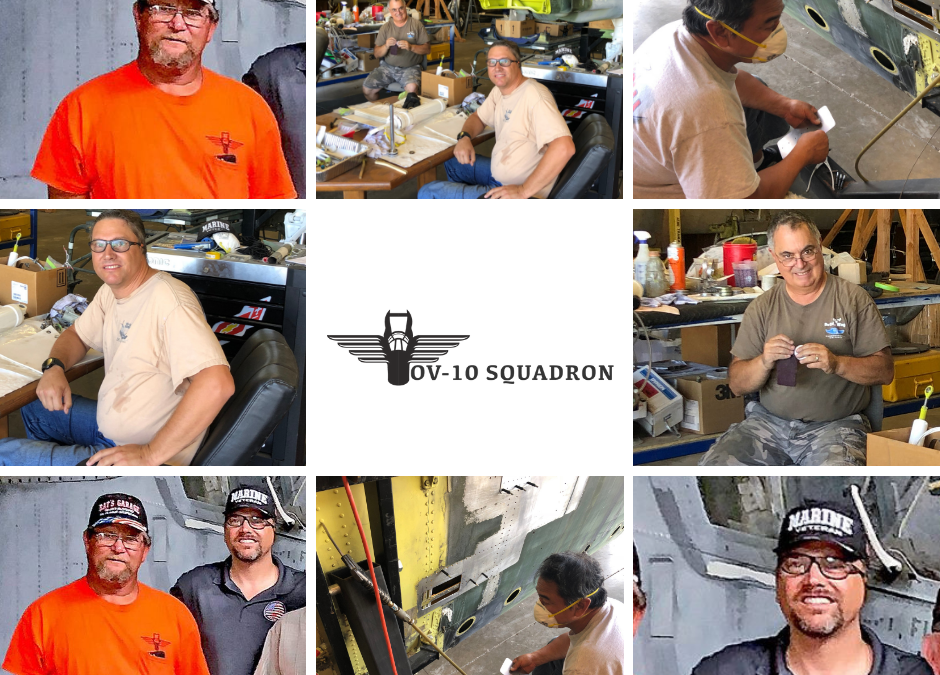
by Michael Jarvis | Jun 13, 2018 | News
You might or might not have heard of the saying “Behind every great build is a great team”. In this case, it takes a squadron. The guys at OV-10 Squadron have been restoring the legendary OV-10 Bronco back to its former glory. For years, the team has put in the time and effort into restoring these epic warbirds. The team aims to have these iconic fleet of aircraft returned to their natural luster, much like how it rolled out of the assembly line back in ‘69. They see to it that the planes could once again soar and maneuver across the skies like a 9900-pound, reinforced, metal butterfly, capable of delivering its sting like a true light-armed, rocket-launching, payload-dropping, bullet-resistant bee even without any offensive measures ready.
The build team at OV-10 Squadron is composed of a handful of people, all of whom have their own specialties. John is one of our members here at the site. He used to work with the OV-10 Broncos in the Marines back during Operation Desert Storm. His deep knowledge about the warbirds makes him one of our assets for the project build. He works with the team and sees to it that every work done on the OV-10s is accurate.
Freddie, on the other hand, mostly handles metal work and riveting. With Jose, they work on the body of the aircraft, doing patchwork where necessary and fabricating components needed for the body. Paul works with Phil prepping the plane’s body; they also work on disassembling the plane for further procedures.
Paul has a mechanical background and works with the local aerospace museum when he’s not at the site. His mechanical skills are broad, ranging from aircraft restorations to military vehicles as well. He heads the motor pool down at the Planes of Fame Air Museum in Chino, California and enjoys working with tanks, ambulances and bikes as much as he enjoys working on the OV-10.
If there’s anything to know about the progress of the build, Brian’s your go-to guy. Brian works alongside the team and contributes with the mechanics and hydraulic components of the plane. He owes his mechanical skills from a Korean War veteran. Having restored a P-51 Mustang back in the day, he’s now currently providing his skills with the restoration of the OV-10 Bronco.
Matt is in charge of delegating the tasks required. He also screens the people who want to pitch in with the effort. As stated before, some drop by without prior experience to restoring planes. As long as they merge well with the rest of the team and don’t mind getting their hands dirty, they’re more than welcome to join the cause. It generally doesn’t matter how skilled a would-be member is, as long as they have the drive and passion for these planes.
The team has come a long way since being a five-man team. We’re seeing more and more people showing interest in the restoration of OV-10. And even though each team member has their own specializations, the restoration provides them with the opportunity to develop other skills. A team member might work on painting though he usually works on fabrication. If there’s anything they need doing, each member voluntarily pitches in.
The restoration itself is not a walk in the park. Every component has to be accurate and sturdily built to meet the requirements the team has set out – to have a fully restored plane that can also perform as well as it looks. Planes aren’t like cars where one could pull it on the side of the road if it breaks down. The restoration team cannot afford a breakdown during flight or they risk the safety of the pilot as well as wasting all their efforts in the project. That is why it is imperative that the team makes the plane work flawlessly. With this goal set for the OV-10 squadron, the team takes their time to make the OV-10 sky-worthy, and as Brian would state it: “it has to be done right, not right now.”
The restoration of the OV-10 Bronco is currently in progress, if you want to know more about the plane and the project, you can leave a message through our Contact page and we’ll get back to you as soon as possible. You can also drop by our headquarters located in the Leading Edge Avionics Hangar at John Wayne/Orange County Airport. The restoration hangar is located at Chino Airport, California. So if you have the skills and the passion for aircraft and would want to be a member of the OV-10 squadron crew, don’t hesitate to get in touch with us.

by Patty Wagstaff | May 24, 2018 | News
The prototype for one of the world’s coolest airplanes was built in a garage. This won’t surprise homebuilders, but it might military history enthusiasts.
(more…)

by Michael Jarvis | May 24, 2018 | News
The prototype for one of the world’s coolest airplanes was built in a garage. This won’t surprise homebuilders, but it might military history enthusiasts.

by Michael Jarvis | May 14, 2018 | News
In previous blog topics, we’ve talked about how the OV-10 was ahead of its time by being perfectly suited for rugged, backcountry operations during the Vietnam War.
The OV-10 was designed with the COIN mission in mind—COIN meaning Counter-Insurgency. During the time the plane was developed and in-demand, insurgents were nestled high in the thickly covered tree lines of rolling hills and deep in the sprawling tropical jungles of Vietnam.
In order to function effectively in this kind of rough setting, an aircraft had to be capable of long loiter, quick takeoff, short taxi times, as well as be able to be repaired by what tools were readily available. Not to mention the requirement of the pilots of being able to clearly see what was going on in front and around you.
Jets were too fast, spearing through air zones at speeds where prolonged and focused observation simply just wasn’t possible. Helicopters could’ve done the job if it weren’t for their bulkiness and vulnerability. The OV-10, meanwhile, answered that long order perfectly.
In one of our previous blogs, we explained why and how the OV-10 worked so well as a versatile forward air controller and reconnaissance aircraft. Thanks to its maneuverability, as testified by United States Army Air Forces fighter pilot and all-around legendary aviator, Bob Hoover; and its ruggedness as well as its capability of operating in austere environments, the OV-10 provided much-needed control over the skies and battlefields in the campaigns it fought in.
But did you know that the OV-10 is fighting new wars of its own today, away from Vietnam, away from Iraq and Syria, and right here on American soil?
If you’re a citizen of California, you’ll be glad to know that all kinds of wildfires, forest fires and brush fires in the Golden State are being fought and extinguished by the one of a kind North American Rockwell OV-10 Bronco.
The California Department of Forestry and Fire Protection (CAL FIRE) acquired 15 OV-10As from the Department of Defense in 1993. These OV-10As have been converted and are in use as specialized air attack planes. The CAL FIRE state that the OV-10s are “newer, larger, faster, provide a larger field of vision for the crew and are more maneuverable.”
You’ll recall from our previous blog posts that the OV-10 has what aviators call a “greenhouse canopy” for its pilots. This is a fancy way of saying “a huge glass chamber that people can look out of.” If you’ve ever seen an OV-10 before, you’ve probably noticed that it has a large cockpit that equips its two-person crew with an equally large, unobstructed view.
This, along with its amazing nimbleness as an aircraft, is precisely why CAL FIRE uses the OV-10 as a command and control center of aircraft during wildland fire operations. The crew inside the OV-10 provides tactical coordination with the incident commander on the ground, providing details such as the location, movement and spread of the fire. They then direct CAL FIRE’s heavy-duty air tankers where to make the necessary drops of fire extinguishing material.
Their long loiter capabilities allow them to supervise over fire operations for more than 5 hours at a time. CAL FIRE’s OV-10s have been upgraded with the avionics and navigation-communication systems required to properly coordinate firefighting assets.
You can rest assured that the forests all over California are under the watchful eye of the OV-10 Bronco. A plane which has been around for some time, and will continue to stick around thanks to not only its strengths but also to the patient, dedicated people who put in the time and effort to keep the plane in the skies.
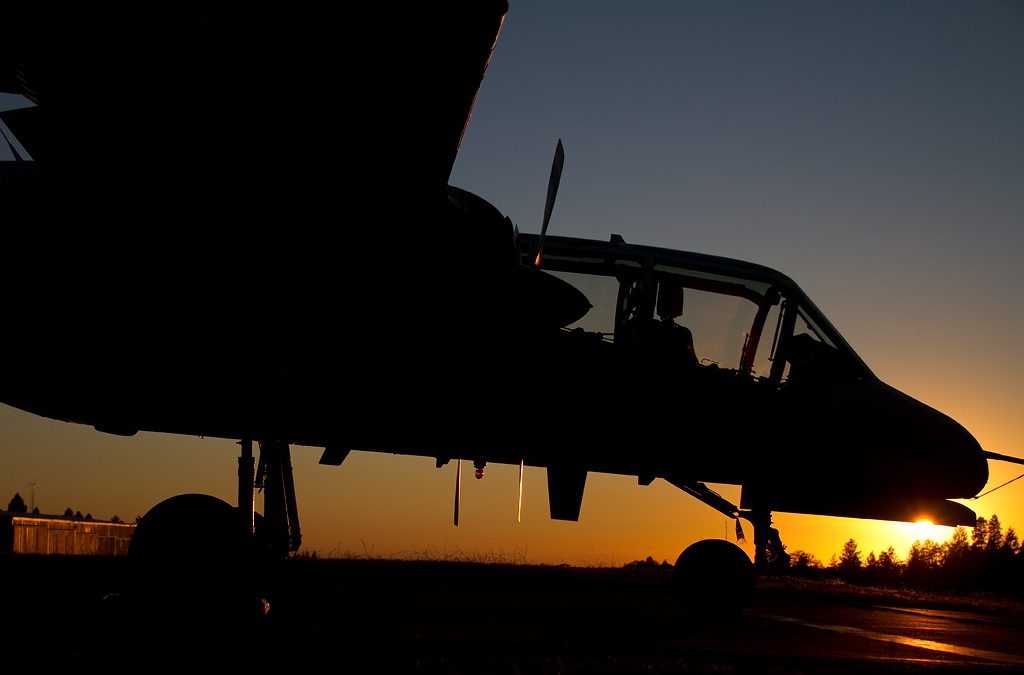
by Michael Jarvis | May 7, 2018 | News
The OV-10 Bronco was an innovation in aviation that reflected the needs and demands of the time when it was developed. Manufactured during the middle-late 20th century, this twin turbo-propeller aircraft had a blend of characteristics from both jet and helicopter.
Throughout the years, the OV-10 underwent a handful of different upgrades and modifications. These modifications produced the different models we know today.
Some notable models were: the original production version OV-10A; then the OV-10B, a “target tug” variant of the plane for Germany; the OV-10D, the second generation Bronco outfitted with night observation laser capabilities and strengthened structural features; and the more recent OV-10G+ under the Combat Dragon II program.
What is the Combat Dragon II program?
Combat Dragon II is a “limited objective experiment/joint combat validation” built upon the Imminent Fury research program of 2007. Simply put, the Combat Dragon II was carried out to determine whether a turbo propeller-driven light attack aircraft could improve “synergy and coordination” between air and ground forces. You can read more about this here.
Why the OV-10 for Combat Dragon II?
During its briefing, the project was stated to be “aircraft agnostic” right from the very beginning. What this meant is that there was no special reason as to why the OV-10 was chosen, aside from immediate availability. To quote, “the chosen platform was not as important as testing the associated doctrine, tactics and other procedures.”
We can’t deny though that the OV-10 did offer numerous capabilities right off the bat for the purposes of the project. Being developed as a light attack and forward air control with versatility and ruggedness in mind, the OV-10 proved more than capable to carry out close air support and reconnaissance, factors which were vital for the Combat Dragon II program.
The OV-10G+
The current Combat Dragon II effort is kept low-profile but with basic facts available to the public through effective searching. One fact that is out and about is that a couple of OV-10G+ planes were deployed to Iraq in 2016 to combat the ISIS with outstanding results.
What sets apart the OV-10G+ from the rest of the models?
The OV-10G+ is a direct result of the Combat Dragon II program, built from OV-10D+ planes handed over by NASA. The OV-10G+ is outfitted with different armaments and enhanced capabilities such as “sensors, weapons and self-defense systems such as missile approach warning sensors and decoy flares.”
Under the management of the Naval Air Systems Command and with a budget of 20 million USD, here are a few things the OV-10G+ has:
- Garrett T76G-420/421 turboprops, the original turbo propellers for the OV-10D+ model, but with four-bladed Hartzell propellers. Hartzell composite propellers reduce weight, noise produced, vibration while enjoying durability and longevity of material
- L3 Wescam MX-15HD sensor turrets, used for medium-altitude covert intelligence, surveillance and reconnaissance operations. MX-15 sensor turrets have different features and benefits such as multi-sensor imaging, image blending, enhanced local area processing, stabilization and weight-sensitivity
- 70mm APKWS II (Advanced Precision Kill Weapon System) rockets, heightening the aircraft’s target acquisition and precision striking capabilities.
- Protracted and versatile operational capability. Although the OV-10 was already a rugged player from the start, the Combat Dragon II sought to enhance those capabilities with added systems in order to reach its goal of developing a “simple, nimble combat aircraft capable of long loiter and on-call reconnaissance and attack duty, able to operate from austere airfields and under primitive conditions.”
“Flying snipers”
The final product of all these modifications under the program resulted in what aviation expert Tyler Rogoway called, “flying snipers for special operations hunting ISIS in Iraq.” Everything considered, the OV-10G+ Broncos “could observe with great clarity from on high, collection intelligence and stalk the enemy. They could also kill that enemy with incredibly accuracy.”
What does this mean for the Bronco?
Essentially, the term “light support aircraft” is being revitalized in the eyes of military aviation. The OV-10G+ Broncos are showing the brass that not everything has to be fast jets, and that the cost-effective light support aircraft has something significant to offer in all military endeavors and efforts.
Learn more about our effort in restoring this venerable piece of military aviation history by contacting us through our contact page or by browsing the “Project” page of our website.

by Michael Jarvis | May 1, 2018 | News
Developed in the 1960s, the twin turbo-propeller OV-10 Bronco was ahead of its time in terms of its maneuverability, utility and ruggedness. Having served under the US Marine Corps, the US Navy and the US Air Force, something truly great can be said about the usefulness and the power of this plane.
As stated in the OV-10 Bronco Association’s United States Air Force Bronco page, the United States Air Force received its first delivery of OV-10 Broncos in February 23, 1968. The aircraft’s primary role was as a forward air controller, carrying out different reconnaissance and support sorties.
Forward air controllers are to heavier-duty military aircrafts much like how scouts are to the cavalry. They work reconnaissance, and “check” to figure out the conditions in a certain area.
Different respected online aerospace and military publications give us a historical perspective into the developments that the OV-10 Bronco underwent.
The “Project CHECO Southeast Asia Report” by Joseph V. Potter made in the year 1969 details two vital operations during the OV-10’s early years: Operations “Combat Bronco” and “Misty Bronco.”
Operation “Combat Bronco”
In July 31, 1968, when the first OV-10s under the USAF reached South Vietnam, began Operation “Combat Bronco,” which was an active operational evaluation and testing for the OV-10A. The planes were assigned to the 19th TASS (Tactical Air Support Squadron) and the 504th TASG (Tactical Air Support Group) at Bien Hoa Air Base in South Vietnam.
During this time, the planes conducted different types of combat-related sorties such as gunship direction, visual reconnaissance, aircraft escort, day/night strike direction, bomb damage assessment and aerial artillery direction.
Operation “Misty Bronco”
In April to June of 1969, the USAF conducted Operation “Misty Bronco” which was designed to evaluate the performance of the OV-10 as a light strike aircraft. Results were generally positive and come October of the same year, all of the USAF’s OV-10s were armed with 7.62mm M60C machine guns and 2.75in rockets as can be seen in Military Factory.
Project “Pave Nail”
In the article “PAVE NAIL: There at the Beginning of the Precision Weapons Revolutions”, expert Darrel Whitcomb studies the modernization and advancements in military technology; more specifically, the integration of the LORAN and the Pave Spot system into the OV-10 aircraft:
In 1971, the 23rd TASS in Thailand’s Nakhon Phanom Air Base received a couple of modifications to their OV-10 airplanes courtesy of the Ling-Temco-Vought (LTV) Corporation in Dallas, TX.
These modifications included the addition of a laser designation system by the name of Pave Spot. This incorporated a low light level and magnification capability for more effective day-night targeting. One can imagine the Pave Spot system as a sort of laser tracking device that precisely “paints” targets for heavier guns to rain down on.
LORAN (Long range navigation) equipment was also armed on the planes for better navigation, and innovatively, aircraft engineers devised a way for the LORAN and the Pave Spot system to communicate with each other and determine the coordinates of the target being designated.
The assignment of the OV-10s to the Nakhon Phanom Air Base was called Project Pave Nail, and it was these OV-10s that eventually joined the effort to intercept enemy patrols and logistic chains on the Ho Chi Minh trail. Working closely with McDonnell F-4 Phantom IIs, these OV-10s from the 23rd TASS were the “point” to their “shoot.”
USAF Capt. Steven Bennett
USAF Major Donald K. Schneider’s “Air Force Heroes in Vietnam” recounts the stories of the brave souls who gave more to their country than it could truly repay. One of those brave soldiers was USAF Captain Steven Bennett.
US Air Force Captain Steven Bennett died bravely in 1972 in the Gulf of Tonkin in South Vietnam.
In an OV-10A Bronco, Capt. Bennett was flying operations for three hours providing combat support and carrying out artillery adjustment missions near the city of Quang Tri, when he received a call for assistance from a small South Vietnamese detachment. They were being stalked by a large Viet Cong force and faced being overrun.
With no nearby friendly fighters, and the high risk of heavy collateral damage from supporting naval gunfire, Capt. Bennett decided to quickly fly over and provide support by strafing the enemy.
These Viet Cong were battle-hardened, and equipped with heat-seeking SAM 7 missiles—one of the few dangers faced by low-flying aircraft such as the OV-10.
Capt. Bennett managed to pump in five strafing runs before his left wing was hit by an enemy projectile. Seeking an emergency landing, he opted to ditch in the Gulf of Tonkin, knowing full-well that the cockpit would suffer greatly from such an impact. No OV-10 pilot ever survived from a ditching.
His plane dived nose first into the water. His Marine companion/gunfire spotter managed to escape from the wreckage but Capt. Bennett, trapped in the pilot’s cockpit, did not have such a fortune. His body was recovered the next day.
Capt. Bennett was posthumously awarded the Medal of Honor for his sacrifice on Aug. 8, 1974.
Conclusion
The USAF received a total of 157 OV-10A’s at this time. A reported 64 was lost in conflict. The USAF retired its use of the OV-10 in September 1991, although there are recent developments such as the two experimental OV-10s deployed to support the Syria and Iraq-based military campaign: Operation Inherent Resolve last summer of 2015.
Indeed, interesting things await the OV-10 in its near future with different groups seeking to revive the Vietnam-era aircraft and suit it for more modern operations. OV-10 Squadron is an organization dedicated to the restoration of this venerable piece of aviation history. Read more about us on our website!

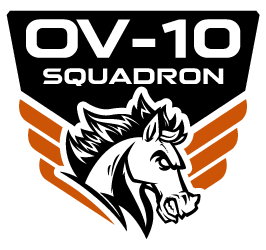







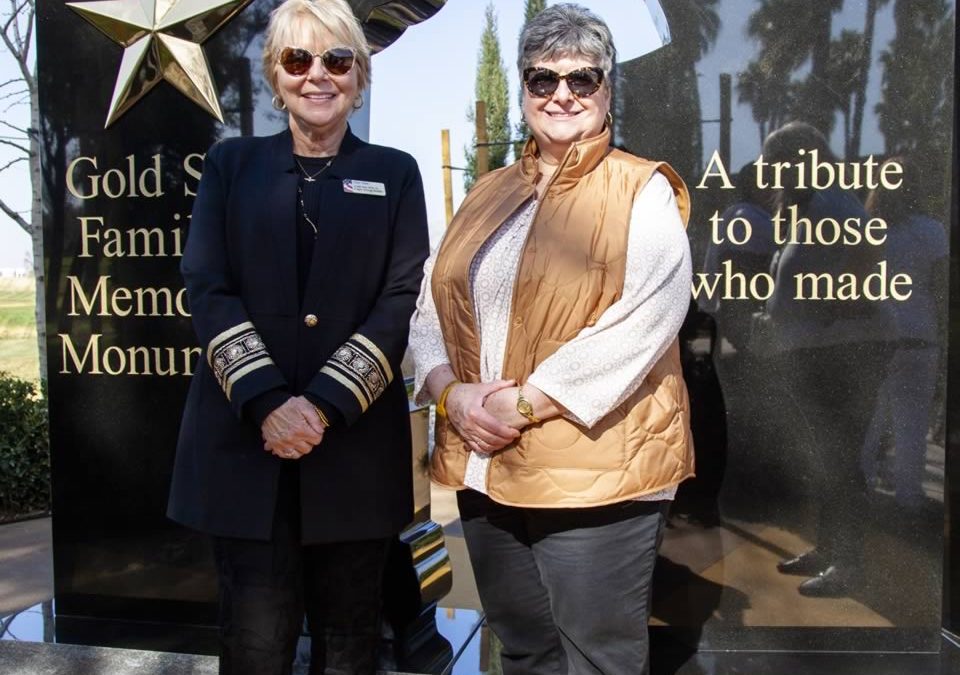
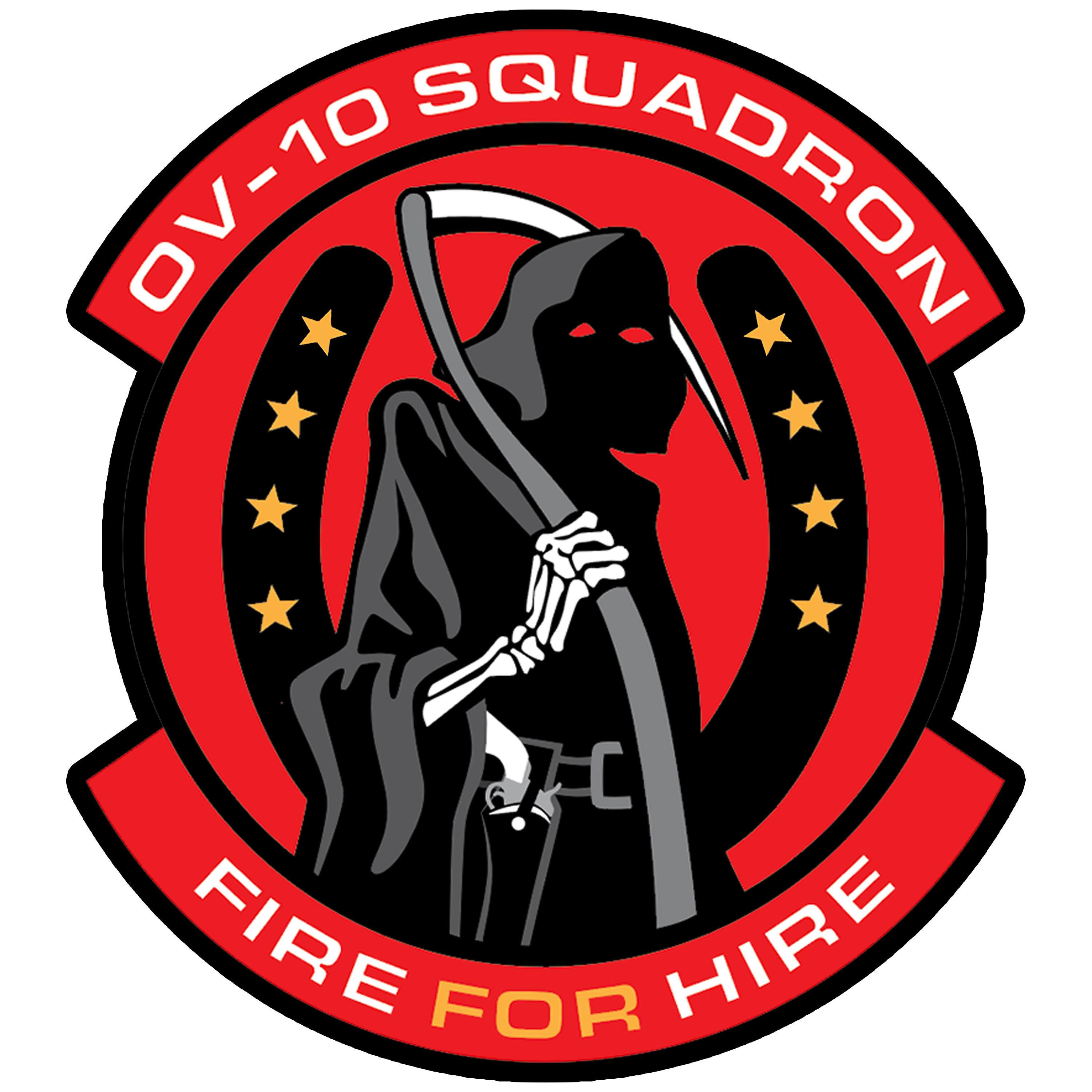
Recent Comments